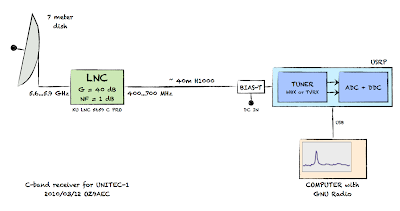Video recording of the HO-68 / XW-1 Chinese amateur radio satellite in linear transponder mode on November 9, 2010. Recorded using the Universal Software Radio Peripheral (USRP) with RFX400 daughterboard and GNU Radio software receiver.
receiver
GQRX receiving the HO-68 satellite
The gqrx software receiver implemented with GNU Radio and Qt GUI is now taking shape and becoming useful. Yesterday evening I went to OZ7SAT and had the USRP+WBX connected to a real antenna tracking amateur radio satellites. The video below shows reception of the evening pass of HO-68, aka. XW-1.
The downsampling experiment
As I mentioned in my previous post, my “optimizations” of the multi-mode receiver code caused a sudden loss in performance.This was a big surprise because what I did was to replace two filters with only one, which I would expected to yield a performance gain and certainly not a loss. What happened at the same time was that the sample rate in the demodulators went from 50 ksps to 250 ksps and it was the responsibility of the demodulators to downsample this to 50 ksps. I suspected that this might have cause the increased CPU load and I have set up a simple experiment to confirm it.
AM/FM/SSB software receiver with Qt GUI
I have been a bit quiet over the last few weeks but don’t you worry, it is only because I have been busy and I can now present you what I have been tinkering with during the last few weeks: An AM, FM, SSB and CW receiver implemented using GNU Radio (python) and Qt graphical user interface.
Broken RFX1200 and more sensitivity measurements
I went to OZ7SAT today to do some measurements on the receiver boards. I wanted to see how the sensitivities compare to that of the WBX receiver that I have measured earlier using a CW signal and SSB receiver. The criteria was again to find the weakest signal that I could both hear and see on the spectrum scope and that I would be able to decode if it was a Morse code transmission. The limiting parameter is actually the spectrum scope, because I can hear tones much weaker than what is visible on the 512 channel FFT scope.
VO-52 satellite with GNU Radio, USRP and WBX
On Saturday 10 July 2010, I have recorded this pass of VO-52. It is the linear transponder downlink between 145.875 and 145.925 MHz. I really don’t understand why people get so crowded in the middle of the passband when there is 50 kHz to play with.
Patched AGC2 block and updated SSB/CW receiver
You may have noticed the weird construction I used in the SSB/CW receiver V0.7 implemented in the GNU Radio companion. It was using three AGC2 blocks with different decay rates, running in parallel and selecting one of them using a selector. The reason why I didn’t just use one block and set the decay rate of the block using an option menu or a slider was that this method didn’t work! Today I decided to dig deeper into the code and see how to fix this.
C-band Receiver Hardware for UNITEC-1
With only a few days left until the launch of UNITEC-1 (May 17) to Venus, we are getting ready to track it and I am trying to catch up on the documentation part – this time a brief description of the receiver hardware.
Recall the system architecture where the 5.84 GHz RF signal is converted to 640 MHz using the KU LNC 5659 C PRO low noise down converter, and…
This article gives a high level walkthrough of the receiver used to convert the 640 MHz IF to digital baseband, i.e. the blue box called USRP in the above diagram.
SSTV Robot OZ9STV with USRP and WBX
I was fooling around with the USRP / WBX on the 2 meter band tonight when I suddenly stumbled upon some very strong SSTV transmission. It turned out to be the OZ9STV robot located only a few kilometers from me. That explained why I had more than 40 dB SNR even though I was only using a bad whip antenna indoors.
UNITEC-1 5.8 GHz Receiver Test Using OZ7IGY
![]()
Tuesday, April 13, 2010 we finally got a chance to test the 5.8 GHz receiver for the UNITEC-1 ground station on the air. The weather was nice and the weak wind allowed us to be on the roof and listen for the OZ7IGY beacon 40 km away.
